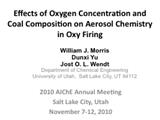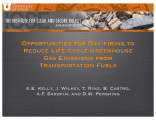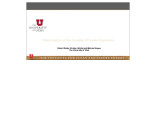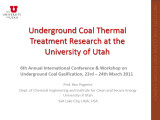TO
| Title | Date | Subject | Description | ||
|---|---|---|---|---|---|
| 51 |
 |
Pore scale analysis of oil shale pyrolysis by X-ray CT and LB simulation | 2010-09-09 | pore scale analysis; oil shale pyrolysis; X-ray CT; LB simulation; oil shale; shale oil procuction; pore structure | There are important questions concerning the quality and volume of pore space that is created when oil shale is pyrolyzed for the purpose of producing shale oil. In this paper, we pyrolyzed 1.9 cm diameter cores at different temperatures and heating rates. Detailed 3D imaging of the core before and ... |
| 52 |
 |
The effects of oxy-firing conditions on gas-phase mercury oxidation by chlorine and bromine: Topical report: April 2009 to June 2010 | 2010-10 | oxy-firing conditions; gas-phase mercury oxidation; bench-scale experiments; liquid-phase oxidation | Bench-scale experiments were conducted in a quartz-lined, natural gas-fired reactor with the combustion air replaced with a blend of 27 mole percent oxygen, with the balance carbon dioxide. Quench rates of 210 and 440 K/s were tested. In the absence of sulfur dioxide, the oxy-firing environment caus... |
| 53 |
 |
Phase 2: Clean and secure energy from coal: Quarterly progress report: July 1, 2010 to September 30, 2010 | 2010-10-01 | domestic coal resources; CO2 capture; stationary power generation; Oxycoal; OFC; coal | The University of Utah is pursuing research to utilize the vast energy stored in our domestic coal resources and to do so in a manner that will capture CO2 from combustion from stationary power generation. The research is organized around the theme of validation and uncertainty quantification throug... |
| 54 |
 |
Particle image velocimetry of pulverized oxy-coal flames | 2010-11-10 | oxy-fuel combustion of pulverized coal; oxy-fuel; pulverized coal; power production; carbon capture and sequestration; emission reductions | Oxy-fuel combustion of pulverized coal is a promising technology for cost-effective power production with carbon capture and sequestration that has impacts on emission reductions. To fully understand the behavior of turbulent oxy-coal flames, and to validate oxy-coal simulation models, accurate expe... |
| 55 |
 |
Effects of oxygen concentration and coal composition on aerosol chemistry in oxy firing | 2010-11-12 | aerosol chemistry; oxy firing; ICSE; coal aerosols; coal composition | Outline: 1) Objectives 2) Coals examined 3) Furnace, sampling, and analysis 4) Results 5) Conclusions. The objectives of the presentation is to provide a comparison of three different coal aerosols under two different oxy fired scenarios for predicting effects of coal composition on oxy firing. Exam... |
| 56 |
 |
Accelerating deployment of retrofitable CO2 capture technologies through predictivity: (Simulation, verification, validation / uncertainty quantification) - 2010 Annual report (for year 1 of 3) to DOE NNSA from The University of Utah | 2011 | CO2; CO2 capture technologies; predictivity; fossil-fuel utilization | There is an ever increasing national awareness that an effective, sustainable energy future must include fossil-fuel utilization that deploys cost-efficient technologies (both new and retrofit) that significantly improve energy efficiencies and reduce CO2 emissions over existing electric power and t... |
| 57 |
 |
Land and resource management issues relevant to deploying in-situ thermal technologies: Topical Report: October 1, 2009 to December 31, 2010 | 2011-01 | in-situ; oil shale; domestic energy source; oil sands | Utah is home to oil shale resources containing roughly 1.3 trillion barrels of oil equivalent and our nation's richest oil sands resources. If economically feasible and environmentally responsible means of tapping these resources can be developed, these resources could provide a safe and stable dome... |
| 58 |
 |
Policy analysis of produced water issues associated with in-situ thermal technologies: Topical report: October 1, 2009 to December 31, 2010 | 2011-01 | topical report; produced water issues; in situ thermal technologies; oil shale/sands; water rights; domestic energy source | Commercial scale oil shale and oil sands development will require water, the amount of which will depend on the technologies adopted and the scale of development that occurs. Water in oil shale and oil sands country is already in scarce supply, and because of the arid nature of the region and limita... |
| 59 |
 |
Phase 2: Clean and secure energy from coal: Quarterly progress report: October 1, 2010 to December 31, 2010 | 2011-01-31 | domestic coal resources; CO2 capture; stationary power generation; LES; DQMOM approach; oxy-coal flames; coal | The University of Utah is pursuing research to utilize the vast energy stored in our domestic coal resources and to do so in a manner that will capture CO2 from combustion from stationary power generation. The research is organized around the theme of validation and uncertainty quantification throug... |
| 60 |
 |
Subtask 6.1: Engineering process models for economic impact analysis | 2011-03-10 | engineering process models; economic impact analysis; domestic heavy oil; developing domestic heavy oil/sands/shale resources | A presentation given at the Unconventional Fuels from Oil Shale and Oil Sands Project Review Meeting on March 10-11, 2011. In the project objectives, the purpose of assessment is to "Examine limiting factors to the development of domestic heavy oil, oil sands, and oil shale resources. Identify poli... |
| 61 |
 |
Subtask 4.3: Multiscale thermal processing of oil shale | 2011-03-10 | thermal processing; oil shale; oil shale treatment; thermal treatment | |
| 62 |
 |
Subtask 4.4: Effect of oil shale processing on water composition | 2011-03-10 | oil shale processing; water composition; unconventional fuels; oil shale; oil sands; oil shale development | A presentation at the Unconventional Fuels from Oil Shale and Oil Sands Project Review Meeting on March 10-11, 2011. The overall goal is to asses aquifers in the Uinta Basin to determine where saline water (produced along with conventional petroleum development) can be disposed without harming fresh... |
| 63 |
 |
Subtask 4.5: Pore scale analysis of oil shale/sands pyrolysis | 2011-03-10 | pore scale analysis; oil shale pyrolysis; oil sands pyrolysis; x-ray CT; pore network structure; flow simulation; LB method | A presentation given at the Unconventional Fuels from Oil Shale and Oil Sands Project Review Meeting on March 10-11, 2011. |
| 64 |
 |
Opportunities for oxy-firing to reduce life-cycle greenhouse gas emissions from transportation fuels | 2011-03-10 | GHG; oxy-firing; reduce greenhouse gas emissions; transportation fuel emissions; CO2 analysis; oil sands | The outline covers in this presentation covers: GHGs and the transportation fuel cycle. Motivation for reducing GHG emissions. Use of oxy-firing for CO2 capture in refining of conventional fuel. Use of oxy-firing for extraction and upgrading of oil sands. GHG emissions from other scenarios Would oxy... |
| 65 |
 |
Subtask 4.6: Kerogen/asphaltene/mineral matrix: Structure and interactions | 2011-03-10 | DOE review meeting; mineral matrix; recover organic material from oil shale/sands | A presentation given at the Unconventional Fuels from Oil Shale and Oil Sands Project Review Meeting on March 10-11, 2011. |
| 66 |
 |
A market assessment of heavy oil, oil sands, and oil shale resources | 2011-03-10 | unconventional fuels; market assessment; developing domestic heavy oil, oil sands, and oil shale resources; preliminary infrastructure needs | A presentation given at the Unconventional Fuels from Oil Shale and Oil Sands Project Review Meeting on March 10-11, 2011. |
| 67 |
 |
Policy analysis of the Canadian oil sands experience | 2011-03-10 | policy analysis; Canadian oil sands experience; oil sands; federal oil sands resources; oil sands development; unconventional fuels | The presentation goes over analyzing the relevance of the Canadian experience to U. S. oil sands development. This report focuses on federal oil sands resources, specifically potential development in the STSA's. No Current development on federal lands, despite leasing authorization under the Combine... |
| 68 |
 |
Subtask 3.2: Flameless oxy-gas process heaters for efficient CO2 capture | 2011-03-11 | Oxy-gas process heaters; efficient CO2 capture; oxy-gas combustion | This is a presentation given at the Unconventional Fuels from Oil Shale and Oil Sands Project Review Meeting in March 10-11, 2011. |
| 69 |
 |
DOE project review: Subtask 4.2 (B): Examination of in situ production models | 2011-03-11 | DOE project review; in situ production models; oil shale; unconventional fuels; oil sands; geomechanics; general reservoir simulation tool | A presentation given at the Unconventional Fuels from Oil Shale and Oil Sands Project Review Meeting on March 10-11, 2011. The objectives of the presentation is the examination of in-situ production methods, different in-situ production method options, rigorous energy and carbon balances, exploratio... |
| 70 |
 |
Underground coal thermal treatment research at the University of Utah | 2011-03-23 | underground coal; thermal treatment research; University of Utah; underground coal pyrolysis; SNG yeilds; UCTT | 6th Annual International Conference & Workshop on Underground Coal Gasification, 23rd - 24th March 2011 |
| 71 |
 |
Pore scale analysis of oil shale/sands pyrolysis | 2011-03-31 | pore scale analysis; oil shale/sands pyrolysis; shale oil production; domestic oil shale deposits | There are important questions concerning the quality and volume of pore space that is created when oil shale is pyrolyzed for the purpose of producing shale oil. In this report, 1.9 cm diameter cores of Mahogany oil shale were pyrolyzed at different temperatures and heating rates. Detailed 3D imagin... |
| 72 |
 |
Phase II: Clean and Secure Energy from Coal: Quarterly Progress Report: January 1, 2011 to March 30, 2011 | 2011-05-01 | domestic coal resources; CO2 capture; coal; Oxycoal simulation team; coal sequestration | The University of Utah is pursuing research to utilize the vast energy stored in our domestic coal resources and to do so in a manner that will capture CO2 from combustion from stationary power generation. The research is organized around the theme of validation and uncertainty quantification throug... |
| 73 |
 |
XRF data for Skyline 16 | 2011-05-12 | XRF data; Skyline 16; pellets | |
| 74 |
 |
Wild lands and wilderness - Implications for Utah's unconventional fuels industry | 2011-05-17 | unconventional fuels industry; order 3310; maintain wilderness resource inventories; BLM; FLPMA; land management | Presentation given at the 2011 Unconventional Fuels Conference. |
| 75 |
 |
2011 Unconventional Fuels Conference - Welcome/opening remarks | 2011-05-17 | unconventional fuels; opening remarks; coal; oil shale; power generation; transportational fuel infrastructures; carbon capture; agenda | Presentation given at the 2011 University of Utah Unconventional Fuels Conference. |
